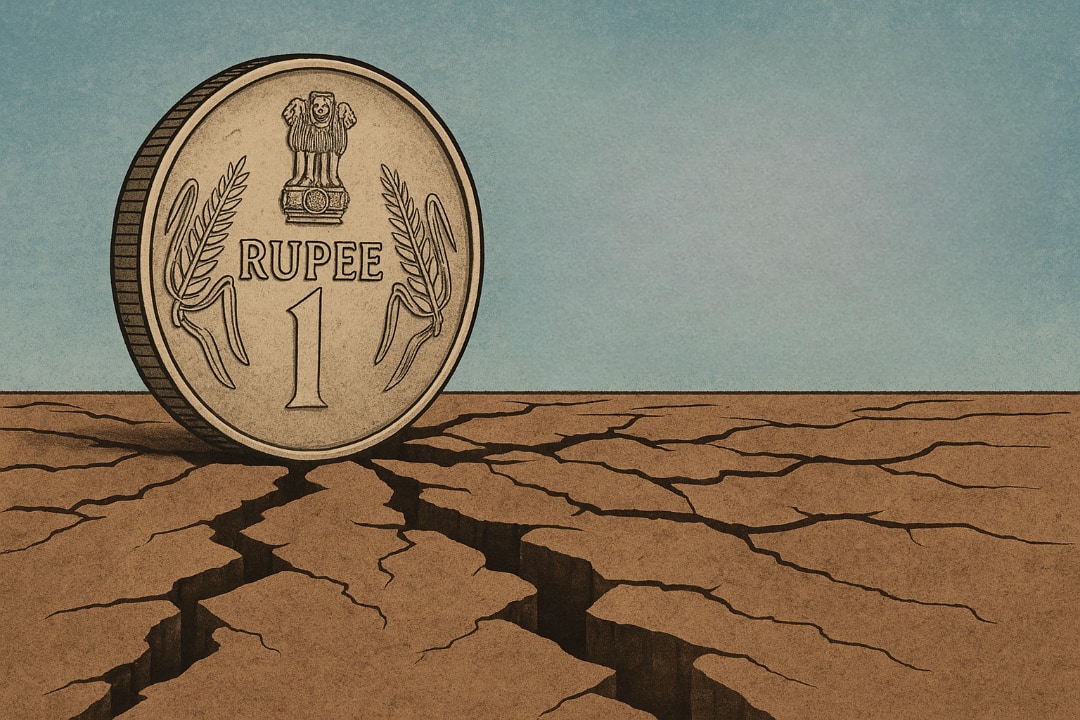As capital inflows soften, remittance buffers come under strain, and India tilts further toward US energy imports, the external account and rupee may come under pressure, according to experts.

Over the past month, the rupee recorded its best weekly gain since January 2023, trading near Rs 85.48 per dollar. (Source: financialexpress)
Even as the rupee may be holding steady for now, the calm could prove deceptive as experts see near-term strength and lower volatility but caution that the stability rests on shifting ground. As capital inflows soften, remittance buffers come under strain, and India tilts further toward US energy imports, the external account and rupee may come under pressure, according to experts.
Over the past month, the rupee recorded its best weekly gain since January 2023, trading near Rs 85.48 per dollar, as the greenback slipped on growing expectations of a US rate cut. Currency volatility has also dropped sharply, with one-month implied volatility on the rupee now at 4.7 per cent while the one-year tenor is near 4.6 per cent, both hovering around two-year lows, according to Reuters data.
“The rupee is now depreciating at a slower pace than before, but the underlying trend remains intact,” says Dharmakirti Joshi, Chief Economist at CRISIL at a recent event organised by EXIM Bank. “Earlier, it was depreciating at around 4 per cent annually; now, it’s closer to 2 per cent. That’s in line with the inflation differential between the US and India, which aligns with purchasing power parity over the long term.”
In the short run, Joshi sees room for more rupee strength. “We should be more optimistic and the rupee should actually begin to strengthen,” he says, noting recent moves in the currency market.
This relative stability has been a comfort to both policymakers and exporters. Yet, the surface calm hides few concerns.
India recorded a current account surplus of $13.5 billion in Q4 FY25 or 1.3 per cent of GDP, the first surplus in a year, driven by strong services exports and record-high remittances. However, the full-year current account deficit stood at $23.3 billion or 0.6 per cent of GDP, largely due to a merchandise trade deficit of $59.5 billion, according to the Reserve Bank of India.
Remittances have been a major shore of the current account, but that buffer may be less reliable going forward.
“I’m a bit concerned about remittances,” says Joshi. “While low oil prices are broadly positive for India, they typically correlate with lower remittance inflows from the Gulf and other countries. And if global growth slows, that could also dampen remittances from developed economies”
India received reportedly $123 billion in remittances in FY25, with inflows in Q4 reaching an all-time high of $33.9 billion but the composition of those flows is shifting. The share from the Gulf — historically tied to oil and construction jobs — has declined to 19 per cent in 2023-24 from nearly 27 per cent in 2016-17, as per the RBI’s 2023-24 survey of remittances. The US, on the other hand, now accounts for nearly 28 per cent of all remittances, reflecting India’s growing tech diaspora. That leaves inflows more exposed to US growth and labour market cycles.
Capital inflows, too, are slowed. According to data from the National Securities Depository Ltd (NSDL), while May was the strongest month for foreign portfolio investments (FPIs) in 2025 with net FPI inflows of Rs 19,860 crore, FPIs have withdrawn Rs 83,576 crore from Indian equities so far this calendar year. The inflows had dropped sharply to Rs 427 crore in 2024 from Rs 1.71 lakh crore in 2023.
“Global savings have come down, particularly from China and other large economies where central banks are reducing their balance sheets,” Joshi notes. “That means there’s less capital available for deploying to emerging markets (like India).”
Further, a subtler but important shift is underway in India’s energy trade. India is now importing more crude oil and liquefied natural gas (LNG) from the United States, a change that is altering the economics of its energy bill. Amid volatility in the Middle East due to the Israel-Iran war, India’s oil purchase from the US jumped to 439,000 bpd (barrels per day) in June from 280,000 bpd in May, as per data from analytics firm Kpler.
“India will probably now have to buy more oil and LNG from the US,” says Saugata Bhattacharya, Member of the Monetary Policy Committee of the RBI. “Given the distance and the logistics involved, this will likely push up the overall cost of crude imports from there.”
India’s crude import bill increased by 2.7 per cent in FY25 to $137 billion from $133.4 billion in FY24, according to data from the Petroleum Planning and Analysis Cell.
The shift toward US energy comes with a currency dimension. “Oil now supports the dollar because the US is now a net exporter of oil as opposed to the European Union, which is the importer of oil. So that advantages the dollar,” Bhattacharya explains.
Overall, despite the strong foreign exchange reserve position, which currently stands at around $697 billion, among the highest in the world, India remains vulnerable to sudden shifts in global capital sentiment.
“If we didn’t have that forex cover and weren't at the mercy of foreigners to finance our deficit, I can imagine what the situation could’ve been in this global environment,” Joshi said. “These two factors are providing some kind of certainty that the rupee won’t wobble too much.”
For now, the rupee remains in a narrow band. “Given the capital flows and potential intervention, my guess is that Rs 84.50 would be the lower bound and Rs 86.50 the upper bound of the rupee’s range.”
While India’s rupee appears well-behaved for now, supported by strong reserves, lower volatility, and central bank intervention, the stability could be conditional based on capital flows, remittances that are shifting in source and sensitivity, and energy imports. In other words, the calm may hold, but the footing may be less solid than it seems.
By continuing you agree to our Privacy Policy & Terms & Conditions
